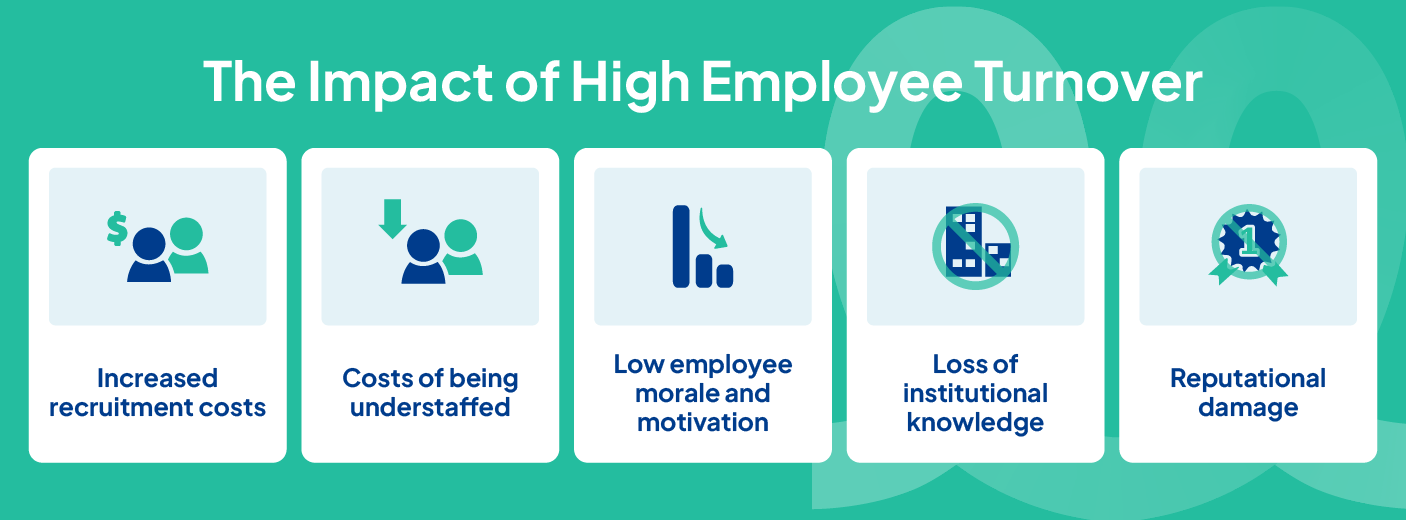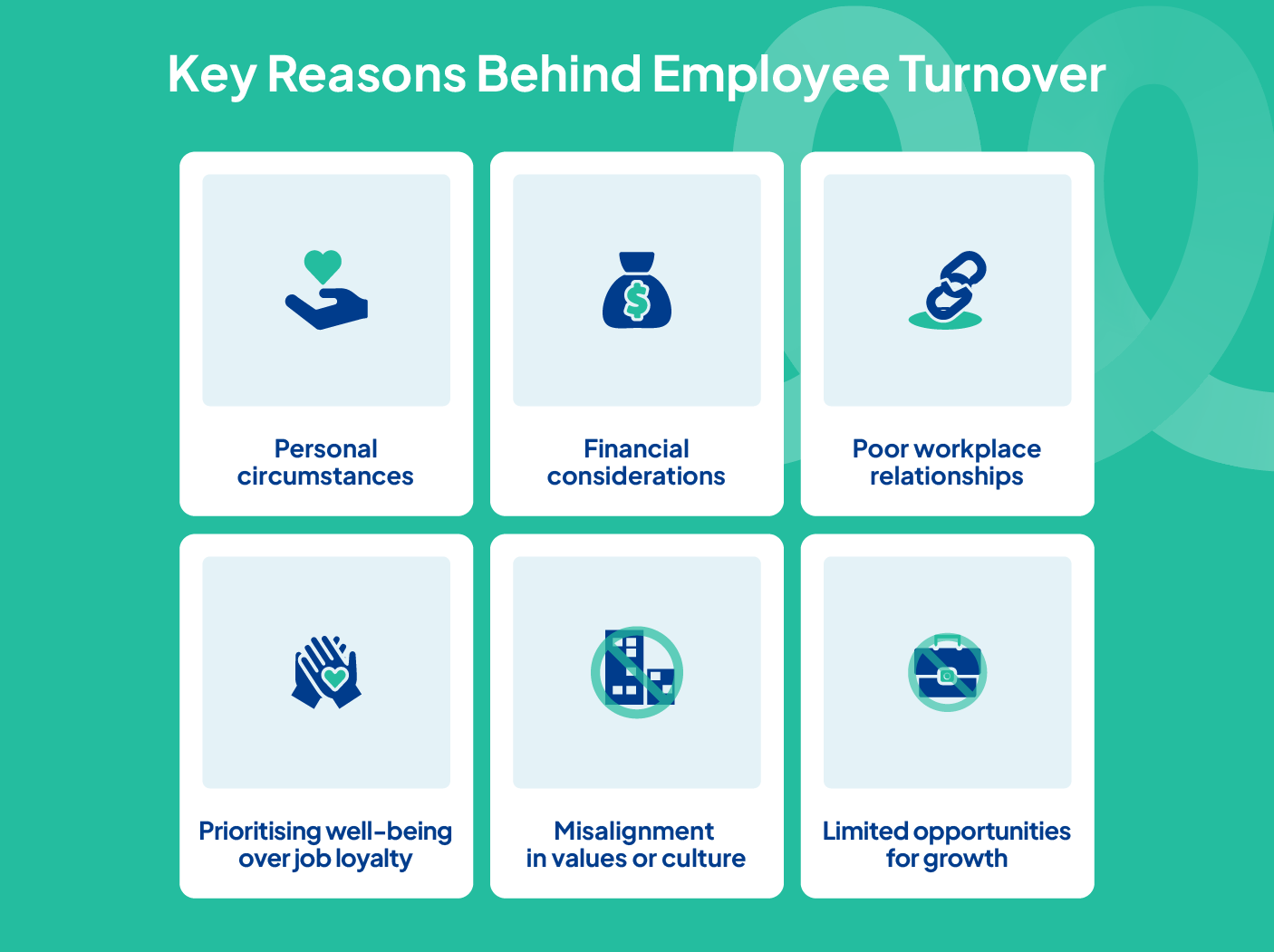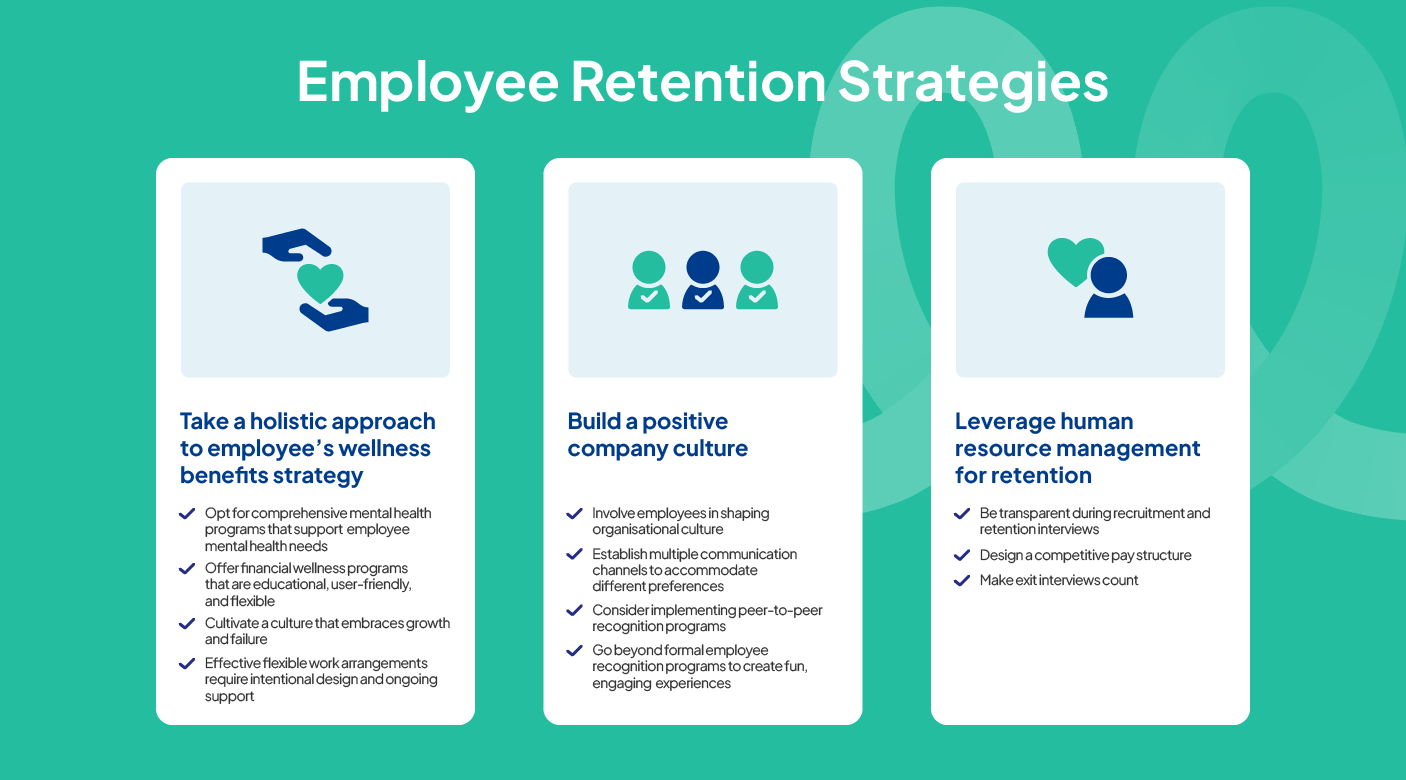In today’s talent-driven economy, retention isn’t just a HR concern; it’s a business-critical priority. High employee turnover affects not just operations and morale, but long-term business performance.
To build an engaged and resilient workforce, organisations need to understand what drives employees to stay, and take strategic steps to support their wellbeing, job satisfaction, and growth. Our article explores the key factors influencing employee retention, along with actionable strategies to strengthen it across your organisation.

Employee retention is defined as an organisation’s ability to retain employees and minimise turnover. It encompasses strategies and processes a company implements to keep its talent and reduce the risk of attrition.
Employee retention is critical for the long-term success and sustainability of any organisation. High turnover can lead to challenges such as:

Improving employee retention starts with understanding the reasons for employee turnover. Common factors include:

To calculate the employee retention rate, you can use the formula below, or an online calculator to work out your employee retention rate.
(Remaining headcount / Original headcount) * 100
Example: If you started the year with 150 employees, and ended with 140 employees, your retention rate will be: (140/ 150) * 100 = 93.3%
Organisations typically calculate their retention rate on an annual basis, though some may do so on a quarterly or monthly basis. The right frequency for your organisation depends on context.
For instance, you’ll need to track your retention rate more frequently if you’re experiencing a sudden rise in employee departures. Monitoring retention monthly can help identify emerging issues early and enable timely intervention.
In addition to retention rates, it’s valuable to track a broader range of indicators, including employee engagement and satisfaction metrics. This allows you to gain deeper insights into retention drivers and supports more informed decisions across recruitment, human resource management, and culture strategies.
Understanding regional trends can help employers design their retention strategies more effectively. The following statistics offer insight into what’s driving employee turnover in key Asian markets like Singapore and Malaysia, as well as what employees are looking for in their workplaces.
Implications for employers:
Employers in Singapore and Malaysia face rising turnover intent, driven by demands for better pay, flexible work schedules, wellbeing support, and strong workplace culture. In Singapore, over half of professionals are considering a job switch, while in Malaysia, toxic environments and lack of belonging are key dealbreakers.
These trends highlight the need for holistic employee retention strategies that prioritise not just compensation, but also employee wellbeing and mental health, recognition, and a sense of community.
To improve retention, employers need to take a multi-faceted approach. The employee retention strategies below address the key factors that influence employee satisfaction, engagement, and long-term commitment.

A one-dimensional approach to wellness is no longer sufficient. Employees today navigate complex personal and professional challenges — from mental health and financial stress, to career uncertainty and changing business environments.
To meet these evolving needs, employers need to adopt a holistic approach that supports all aspects of employee wellbeing.
What employers and HR teams can do:
A positive company culture plays a crucial role in retaining top talent. When employees feel valued, connected, and supported, they’re more likely to stay and contribute meaningfully to the organisation.
Culture shapes the day-to-day experience of work, influencing employee morale, motivation, and trust. By intentionally building a culture that prioritises belonging, recognition, and open communication, employers can strengthen engagement and reduce turnover.
What employers and HR teams can do:
Human resource management plays a critical role in shaping the employee experience, starting from recruitment to offboarding.
A strategic, people-first approach helps identify and address the root causes of turnover, strengthen employee engagement, and create conditions where employees feel supported and motivated to stay. The following strategies can help HR teams align their practices with long-term retention goals.
What employers and HR teams can do:
Improving employee retention calls for a sustained, multi-faceted approach that supports individuals across every stage of their journey. While compensation, culture, and career development matter, mental wellbeing is a key element that shapes how employees show up, remain engaged, and grow with your organisation.
Investing in corporate mental health programs like ThoughtFull isn’t just good for people; it’s good for business. Our solution helps reduce absenteeism, improve engagement, and lower downstream care costs, all while supporting your team through every stage of their journey.
Beyond delivering a seamless end-to-end mental health solution, we partner with organisations to ensure a smooth rollout and sustained employee engagement. This includes close collaboration with your HR team, along with implementing launch communications, ongoing engagement initiatives, and more.
With ThoughtFull, your employees get personalised, accessible care — helping your organisation build a healthier, more resilient workforce.
Sources:
In today’s talent-driven economy, retention isn’t just a HR concern; it’s a business-critical priority. High employee turnover affects not just operations and morale, but long-term business performance.
To build an engaged and resilient workforce, organisations need to understand what drives employees to stay, and take strategic steps to support their wellbeing, job satisfaction, and growth. Our article explores the key factors influencing employee retention, along with actionable strategies to strengthen it across your organisation.

Employee retention is defined as an organisation’s ability to retain employees and minimise turnover. It encompasses strategies and processes a company implements to keep its talent and reduce the risk of attrition.
Employee retention is critical for the long-term success and sustainability of any organisation. High turnover can lead to challenges such as:

Improving employee retention starts with understanding the reasons for employee turnover. Common factors include:

To calculate the employee retention rate, you can use the formula below, or an online calculator to work out your employee retention rate.
(Remaining headcount / Original headcount) * 100
Example: If you started the year with 150 employees, and ended with 140 employees, your retention rate will be: (140/ 150) * 100 = 93.3%
Organisations typically calculate their retention rate on an annual basis, though some may do so on a quarterly or monthly basis. The right frequency for your organisation depends on context.
For instance, you’ll need to track your retention rate more frequently if you’re experiencing a sudden rise in employee departures. Monitoring retention monthly can help identify emerging issues early and enable timely intervention.
In addition to retention rates, it’s valuable to track a broader range of indicators, including employee engagement and satisfaction metrics. This allows you to gain deeper insights into retention drivers and supports more informed decisions across recruitment, human resource management, and culture strategies.
Understanding regional trends can help employers design their retention strategies more effectively. The following statistics offer insight into what’s driving employee turnover in key Asian markets like Singapore and Malaysia, as well as what employees are looking for in their workplaces.
Implications for employers:
Employers in Singapore and Malaysia face rising turnover intent, driven by demands for better pay, flexible work schedules, wellbeing support, and strong workplace culture. In Singapore, over half of professionals are considering a job switch, while in Malaysia, toxic environments and lack of belonging are key dealbreakers.
These trends highlight the need for holistic employee retention strategies that prioritise not just compensation, but also employee wellbeing and mental health, recognition, and a sense of community.
To improve retention, employers need to take a multi-faceted approach. The employee retention strategies below address the key factors that influence employee satisfaction, engagement, and long-term commitment.

A one-dimensional approach to wellness is no longer sufficient. Employees today navigate complex personal and professional challenges — from mental health and financial stress, to career uncertainty and changing business environments.
To meet these evolving needs, employers need to adopt a holistic approach that supports all aspects of employee wellbeing.
What employers and HR teams can do:
A positive company culture plays a crucial role in retaining top talent. When employees feel valued, connected, and supported, they’re more likely to stay and contribute meaningfully to the organisation.
Culture shapes the day-to-day experience of work, influencing employee morale, motivation, and trust. By intentionally building a culture that prioritises belonging, recognition, and open communication, employers can strengthen engagement and reduce turnover.
What employers and HR teams can do:
Human resource management plays a critical role in shaping the employee experience, starting from recruitment to offboarding.
A strategic, people-first approach helps identify and address the root causes of turnover, strengthen employee engagement, and create conditions where employees feel supported and motivated to stay. The following strategies can help HR teams align their practices with long-term retention goals.
What employers and HR teams can do:
Improving employee retention calls for a sustained, multi-faceted approach that supports individuals across every stage of their journey. While compensation, culture, and career development matter, mental wellbeing is a key element that shapes how employees show up, remain engaged, and grow with your organisation.
Investing in corporate mental health programs like ThoughtFull isn’t just good for people; it’s good for business. Our solution helps reduce absenteeism, improve engagement, and lower downstream care costs, all while supporting your team through every stage of their journey.
Beyond delivering a seamless end-to-end mental health solution, we partner with organisations to ensure a smooth rollout and sustained employee engagement. This includes close collaboration with your HR team, along with implementing launch communications, ongoing engagement initiatives, and more.
With ThoughtFull, your employees get personalised, accessible care — helping your organisation build a healthier, more resilient workforce.
Sources:






